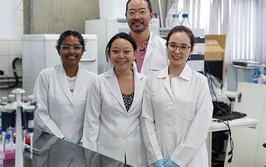Pragmatic Red Tape
Documentation does not ensure effective, efficient or consistent performance. Paper is not a replacement for motivation, competence, and capable employees, working within well-designed processes. So, how do we guarantee quality from lab tests?
To guarantee a ‘standard’ kilogram, meter, or any other SI unit, a network of metrological laboratories exists. The competence of this network means we generally trust ‘the system’. Certainly, it would not be acceptable for the mass of a kilogram to vary – money is involved, afterall. Likewise, laboratory results play an important role in our society. Juries rely on forensic laboratories for evidence, we all have faith in food and environmental analyses, and we trust the findings of medical test results. But can these results always be trusted? Unfortunately, the answer is not clear-cut.
Our belief in pharmaceutical laboratories started to falter around 1970. Following cases of fraud in data submitted by toxicology labs to the US Food and Drug Administration (FDA), 1972 saw the introduction of Good Laboratory Practice (GLP) – the framework within which laboratory studies are planned, performed, monitored, recorded, reported, and archived. GLP makes everything traceable to original raw data and helps assure regulatory authorities that the data submitted are a true reflection of the results obtained during the study. GLP was one of the first quality management systems for laboratories.
In 1978, the US Environmental Protection Agency initiated a certification program for laboratories that analyze drinking water. Similar projects started in several other countries, which resulted in ISO/IEC 17025: General requirements for the competence of testing and calibration laboratories. It was simple. The quality manager defined what ‘quality’ was and wrote procedures. Analysts were expected to read, understand, and act accordingly. But ‘quality’ is a relative term. Here’s the International Organization for Standardization (ISO) definition: “The totality of features and characteristics of a product or service that bear on its ability to satisfy stated or implied needs”. In other words, a product is deemed to be of good quality when it complies with the requirements specified by the client. When projected onto analytical work, quality can be defined as the delivery of reliable information within an agreed time span, under agreed conditions, at agreed costs, and with necessary aftercare – a long way, perhaps, from daily laboratory practice.
From an analyst’s point of view, quality relates to the analysis of a given sample – and can mean finding an answer that meets their own expectations. If the result indicates that the product is out of specifications, the analyst is likely to reanalyze the sample until the result is within specifications. Surprised? A doping laboratory, which acts in compliance with the World Anti-Doping Agency (WADA) international standard, can be similarly flawed by confirmation bias (the tendency of people to favor information that confirms their hypotheses and reject that which does not) because “the objective of the confirmation assay is to accumulate additional information regarding an adverse finding”.
Furthermore, the identification criteria described in technical documents leaves plenty of room for interpretation. Anyone who has worked with liquid chromatography-tandem mass spectrometry (LC-MS/MS) data analysis will be aware that it requires only trivial manipulation of the parameters to acquire the desired result, especially when a ratio is just outside the required limits.
Going back to the laboratory quality management system, remember that it was based on GLP – and the bureaucracy has become a kind of tradition. Often, nobody in the laboratory (except the quality manager) has bothered to read ISO/IEC 17025. It is the quality manager alone that translates the clauses into standard operating procedures (SOPs). The only feedback he or she receives is that it is too bureaucratic.
Have you asked your analysts what their SOPs would look like, if they were involved in their inception? How about providing flow charts rather than long procedures? Quality also means taking the time to think about the design of your processes and evaluating and improving current practice. Certainly, it takes more effort, but a well-designed and accessible system benefits one and all – including quality.
With Peter Kootstra’s background in medical and analytical chemistry, laboratories can no longer have secrets. After more than 25 years working for the government, Peter is now a consultant on analytical chemistry and quality assurance. He is co-owner of Lab-QAcademy, a provider of training courses and workshops on the quality assurance in laboratories. Peter believes that, by following a practical approach, the quality of laboratories can be improved: “If analyst know why rules are necessary, quality will be improved”.

















